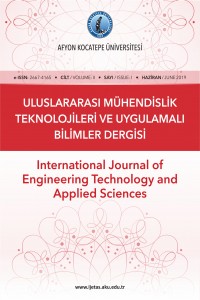Abstract
In this study, a hemispherical head with pad reinforced central nozzle opening that subjected to uniform internal pressure was investigated using Finite Element Methods (FEM) to understand the design procedure. This procedure is handled according to the ASME Boiler and Pressure Vessel Code Section VIII Division 2. This standard contains two parts for the design of pressure vessels, the first part is Design by rules and the second part is Design by analysis. With reference to the ASME standard, axisymmetric finite element models for Elastic, Limit Load and Elastic-Plastic Analysis are used to demonstrate protection against plastic collapse and local failure. Maximum allowable pressures are obtained in accordance with the mentioned design methods and discussed. According to the elastic and limit load analysis methods, obtained plastic collapse results are very close. Besides, the elastic analysis method is observed to be more conservative than the Elastic-Plastic method regarding the evaluation of plastic collapse. On the other hand, for the local failure results, Elastic-Plastic Analysis is observed to be slightly conservative than the Elastic Analysis.
Keywords
Internally Pressurized Pressure Vessels Finite Element Method Design by Rules Design by Analysis
References
- 1. Bhagyashri, U., Mishra, H. (2015). A review on design and analysis of pressure vessel. International Journal of Advance Research and Innovative Ideas in Education 1 (2) 348-353.
- 2. Dhalla, A.K., Jones, G.L. (1986). ASME code classification of pipe stresses: A simplified elastic procedure. International Journal of Pressure Vessels and Piping 26 (2) 145-166.
- 3. Sunil Kumar, D., Suhas, B. (2016). Design and Evaluation of Pressure Vessel as per ASME Section VIII Division 2. International Journal of Innovative Research in Science, Engineering and Technology 5 (10) 17989-18002.
- 4. Thakkar, B.S., Thakkar, S.A. (2012). Design of Pressure Vessel Using ASME Code, Section VIII, Division 1. International Journal of Advanced Engineering Research and Studies 1 (2) 228-234.
- 5. Agrawal, A.K., Ganesh Narayanan, R. (2018). Pull-out tests on tube to sheet joints fabricated by end forming. Journal of Constructional Steel Research 144 186-197.
- 6. Olszewski, A., Wodtke, M., Wójcikowski, A. (2018). FEM Analysis and Experimental Tests of Rigid Riser Hanging System. Polish Maritime Research 25 (2) 108-115.
- 7. Sharifi, S., Gohari, S., Sharifiteshnizi, M., Alebrahim, R., Burvill, C., Yahya, Y., et al., (2018). Fracture of laminated woven GFRP composite pressure vessels under combined low-velocity impact and internal pressure. Archives of Civil and Mechanical Engineering 18 (4) 1715-1728.
- 8. Sharifi, S., Gohari, S., Sharifiteshnizi, M., Vrcelj, Z. (2016). Numerical and experimental study on mechanical strength of internally pressurized laminated woven composite shells incorporated with surface-bounded sensors. Composites Part B: Engineering 94 224-237.
- 9. (2017) ASME Boiler and Pressure Vessel Code Section VIII: Rules for Construction of Pressure Vessels Division 2: Alternative Rules, ASME Boiler and Pressure Vessel Committee on Pressure Vessels.
- 10. (2017) ASME Boiler and Pressure Vessel Code Section II: Materials Part A: Ferrous Material Specifications, ASME Boiler and Pressure Vessel Committee on Materials.
- 11. (2017) ASME Boiler and Pressure Vessel Code Section II: Materials Part D: Properties (Metric), ASME Boiler and Pressure Vessel Committee on Materials.
- 12. Hechmer, J.L., Hollinger, G.L. (1998). 3D Stress Criteria Guidelines for Application, Welding Research Council Bulletin, No: 429, ISSN 0043-2326.
- 13 Peters, D.T., Haley, K., Padmala, A. (2013). ASME Section VIII Division 3 Example Problem Manual, p. 352-356 ISBN 978-0-7918-6881-2
Abstract
Keywords
İç Basınca Maruz Basınçlı Kaplar Sonlu Elemanlar Yöntemi Formüller ile Tasarım Analiz ile Tasarım
References
- 1. Bhagyashri, U., Mishra, H. (2015). A review on design and analysis of pressure vessel. International Journal of Advance Research and Innovative Ideas in Education 1 (2) 348-353.
- 2. Dhalla, A.K., Jones, G.L. (1986). ASME code classification of pipe stresses: A simplified elastic procedure. International Journal of Pressure Vessels and Piping 26 (2) 145-166.
- 3. Sunil Kumar, D., Suhas, B. (2016). Design and Evaluation of Pressure Vessel as per ASME Section VIII Division 2. International Journal of Innovative Research in Science, Engineering and Technology 5 (10) 17989-18002.
- 4. Thakkar, B.S., Thakkar, S.A. (2012). Design of Pressure Vessel Using ASME Code, Section VIII, Division 1. International Journal of Advanced Engineering Research and Studies 1 (2) 228-234.
- 5. Agrawal, A.K., Ganesh Narayanan, R. (2018). Pull-out tests on tube to sheet joints fabricated by end forming. Journal of Constructional Steel Research 144 186-197.
- 6. Olszewski, A., Wodtke, M., Wójcikowski, A. (2018). FEM Analysis and Experimental Tests of Rigid Riser Hanging System. Polish Maritime Research 25 (2) 108-115.
- 7. Sharifi, S., Gohari, S., Sharifiteshnizi, M., Alebrahim, R., Burvill, C., Yahya, Y., et al., (2018). Fracture of laminated woven GFRP composite pressure vessels under combined low-velocity impact and internal pressure. Archives of Civil and Mechanical Engineering 18 (4) 1715-1728.
- 8. Sharifi, S., Gohari, S., Sharifiteshnizi, M., Vrcelj, Z. (2016). Numerical and experimental study on mechanical strength of internally pressurized laminated woven composite shells incorporated with surface-bounded sensors. Composites Part B: Engineering 94 224-237.
- 9. (2017) ASME Boiler and Pressure Vessel Code Section VIII: Rules for Construction of Pressure Vessels Division 2: Alternative Rules, ASME Boiler and Pressure Vessel Committee on Pressure Vessels.
- 10. (2017) ASME Boiler and Pressure Vessel Code Section II: Materials Part A: Ferrous Material Specifications, ASME Boiler and Pressure Vessel Committee on Materials.
- 11. (2017) ASME Boiler and Pressure Vessel Code Section II: Materials Part D: Properties (Metric), ASME Boiler and Pressure Vessel Committee on Materials.
- 12. Hechmer, J.L., Hollinger, G.L. (1998). 3D Stress Criteria Guidelines for Application, Welding Research Council Bulletin, No: 429, ISSN 0043-2326.
- 13 Peters, D.T., Haley, K., Padmala, A. (2013). ASME Section VIII Division 3 Example Problem Manual, p. 352-356 ISBN 978-0-7918-6881-2
Details
| Primary Language | English |
|---|---|
| Subjects | Engineering |
| Journal Section | Articles |
| Authors | |
| Publication Date | June 16, 2019 |
| Submission Date | April 29, 2019 |
| Published in Issue | Year 2019 Volume: 2 Issue: 1 |

